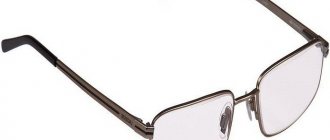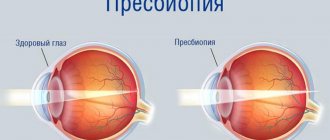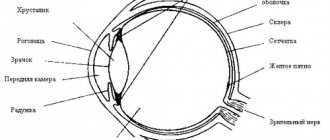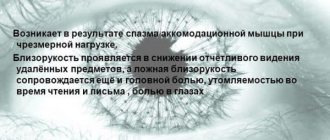Farsightedness - is it a plus or a minus?
Farsightedness (hyperopia) is a vision defect in which the eye sees objects at a distance better, but objects near are blurred.
The disease is associated with improper refraction of light by the eye.
When the eyeball is too “flattened”, which is typical for farsightedness, light rays are focused not on the retina, but behind it. This results in a blurry image.
Lenses for farsightedness “plus” or “minus”
Farsightedness is corrected by convex glasses: they are thicker in the center than at the edges. Convex lenses collect light rays and bring the image closer to the retina, focusing it clearly.
Glasses with converging lenses are “plus”. Their refractive power is measured in diopters with a plus sign.
The parameters of spectacle lenses are determined by a specialist after a thorough examination of the patient’s vision, the curvature of his eyeball and the thickness of the lens.
Causes of farsightedness
The causes of hypermetropia can be:
- the shape of the eyeball is too short, the image focused by the cornea and lens is transferred behind the retina;
- age-related changes that affect the ability of the lens to accurately focus light rays.
Glasses for presbyopia
With the development of age-related farsightedness, when the eye cannot correctly focus vision on a nearby small object, glasses “for reading” are prescribed. In many cases this is enough.
The power of spectacle lenses is measured in positive diopters and depends on the thickness of the lens, the age of the patient and the distance between the object being manipulated and the eye. Typically this distance is 30 cm.
However, with such glasses, the image of distant objects seems fuzzy and blurry. If a farsighted patient also needs distance glasses, bifocal glasses are prescribed.
Bifocal glasses have many modifications. The area of the lens used for close-up vision is located slightly lower or higher in relation to the frame. The parameters are determined by the state of vision and occupation.
For comfortable reading, a distance from the book to the eyes is required - 30-40 cm. A carpenter, accustomed to doing his work at arm's length, needs clear vision at a distance of 60 cm.
It needs a larger segment for near vision and a smaller segment at the top of the glass for distance vision.
In addition, there are also trifocal glasses. They combine three recipes.
In bifocal glasses, through the upper part of the lens it is convenient to look into the distance at a distance of 1.5 m; through the reading segment, close objects are better visible. The gap from 0.5 m to 1.5 m remains a difficult to distinguish zone. If you need to clearly distinguish everything at this distance, they resort to a trifocal spectacle lens, which provides clarity for “intermediate” vision.
To ensure a smooth transition from one zone to another, they began to make “progressively complementary” spectacle lenses. They are slightly more expensive than regular bi- and trifocal ones. Still, some distortion may be felt at the junction of the segments. Patients adapt to trifocal glasses in 5-6 days. Cosmetically, glasses with progressive lenses look more aesthetically pleasing.
Degrees of the disease
There are 3 degrees of development of farsightedness:
- Weak. Up to +2.5 diopters. There are some difficulties when reading small print at a distance of 30 cm. Long-term work causes eye fatigue, expressed in headaches and pain in the eyes.
- Average. From +2.5 to +5 diopters. Distance vision is normal, but the contours of nearby objects are blurred.
- High. From +5 or more diopters. The contours of both distant and close objects are blurred.
Spectacle correction is offered to those suffering from moderate to severe hypermetropia. Glasses are selected with glasses of the highest degree of refraction that the patient can tolerate.
Diagnostics
If the eye is not able to clearly distinguish letters at a distance closer than 30-35 cm, the text is blurred, and reading quickly tires the eyes, it is recommended to consult an ophthalmologist.
The doctor, based on the patient’s complaints, the selection of glasses or by skiascopy, will determine the nature and degree of visual impairment. The exact values of the refraction of the eye are determined at rest of accommodation.
Was the article helpful?
Rate the material on a five-point scale! (2 4.50
Is farsightedness a plus or a minus?
With farsightedness, it is impossible to see nearby objects, but distant objects are clearly visible. This happens because the light flux is not focused strictly on the retina, but is collected behind it.
To correctly answer the question posed in the title, you need to know the principle of operation of the visual system and its possible problems.
How to distinguish myopia from farsightedness
There are certain distinctive features of myopia that are absent in farsightedness:
- concentration of gaze for better focusing on objects that are far away;
- good visibility of objects that are within 20-30 cm in front of the patient;
- myopia is more typical for young people, and farsightedness develops mainly after 45 years.
A person with myopia has difficulty seeing in the distance, while a person with farsightedness has trouble seeing up close. This is the main distinguishing feature of conditions in which visual acuity is impaired. It is important for the doctor to identify them in order to carry out further treatment.
Prevention
Measures to avoid myopia should be taken care of from an early age. Parents should monitor their child's habits and ensure that:
- the distance from the eyes to the text during reading was 30 cm or more;
- visual strain for more than 40 minutes periodically alternated with breaks for rest or physical activity;
- he did not read while lying down, or while riding on public transport;
- the back remained straight when writing at the table;
- lighting was in the range of 60–100 W, and in the evening a table lamp was used;
- devices providing daylight were turned off during active times of the day.
The child must sit correctly at the desk
How to avoid myopia
Complications of the disease
If severe farsightedness occurs from an early age, it can lead to lazy eye syndrome (amblyopia). This means that one eye, which has worse vision, never learns to see well: the brain ignores the signals coming from it and concentrates only on signals from the eye that sees better.
Development of the parts of the brain that process visual information occurs during the first few years of life. If this problem remains unnoticed until the time vision finishes taking shape, the eye that sees worse will remain forever underdeveloped, since the information chain of nerve signals from the eye to the brain will not be developed.
Farsighted astigmatism is a refractive error when astigmatism (a vision defect associated with an abnormal shape of the lens, cornea or eye) is combined with farsightedness. One variant of farsighted astigmatism is the case when the two sides of the cornea are asymmetrical along the horizontal and/or vertical axis and this is combined with the point of convergence of light rays behind the retina.
Farsighted astigmatism can be caused when the sides of the lens surface are asymmetrical along the axis/axes. It is also possible that farsighted astigmatism is the result of a mismatch between the surfaces of both the cornea and the lens. This is complex hypermetropic astigmatism.
If the vision of both the right and left eyes is impaired, the disease will be called hypermetropic astigmatism of both eyes. The International Classification of Diseases does not define such a disease as hypermetropic astigmatism. The ICD-10 code should be determined separately for hypermetropia and astigmatism in the section on refractive error and accommodation.
Which glasses to choose for farsightedness: plus or minus?
→ Home treatment → Eye diseases → Farsightedness
Farsightedness is a special condition of the eye that is often contrasted with myopia. With farsightedness or hypermetropia, the focus of the image when looking at an object falls not on the retina, but behind it.
The farsighted eye is usually shorter than the healthy eye. People who suspect they have this disease often wonder whether farsightedness is a minus or a plus? The choice of glasses and treatment in general depends on this.
- Features of the disease
- What is the difference between farsightedness and nearsightedness?
- Glasses for farsightedness: plus or minus
- Treatment of farsightedness
Features of the disease
Hypermetropia is not as common a disease as myopia. It is believed that the main symptom of this condition is poor near vision, but it is worth noting that poor distance vision also occurs. Farsightedness is often an age-related problem; most people experience its symptoms after 30–40 years.
However, due to congenital structural features of the eye, hypermetropia can occur in children. In this case, it is imperative to immediately engage in vision correction; in children, such a pathology can lead to more serious problems, for example, strabismus.
In addition to decreased near visual acuity, farsighted people are plagued by a number of other symptoms that are not always immediately associated with eye problems. People with hypermetropia often experience the following symptoms:
- a feeling of tension, burning in the eyes, especially after a busy day at work;
- fatigue, periodic rather severe headaches;
- Difficulty reading small texts and looking at nearby objects.
All these phenomena are consequences of farsightedness. Without correction, this disease can begin to progress and cause more and more difficulties. The following degrees of hypermetropia are distinguished depending on the number of diopters by which vision has deteriorated:
- first degree, weak, up to +2 diopters;
- the second degree, more serious, stands out from + 2 – 2.5 to + 4.5 diopters;
- the third degree is the most severe, starting from +4.5 diopters.
In the first stages of the disease, the patient does not feel any serious difficulties; pain in the eyes may begin to appear from working for a long time. If farsightedness is detected at the first degree, the patient often only needs specialized reading glasses, which help to better distinguish small print without unnecessarily causing eye strain.
In later stages, serious discomfort may appear, and it will become extremely difficult to distinguish small fonts and nearby objects. In the third degree of the disease, visual acuity decreases not only near, but at a distance.
Important! Farsightedness almost never occurs at an early age
What is the difference between farsightedness and nearsightedness?
The main difference between these diseases is where the images inside the eye are focused, and this is where the rest of the differences between the two conditions come from. With farsightedness, the image is focused behind the retina, the rays of light are collected literally behind the eye.
With myopia, light rays are focused without reaching the retina. Therefore, with hypermetropia, a person better sees objects located far away, and with myopia, objects located close to them are better. In this regard, glasses for vision correction should be selected with different signs; each disease requires its own diopters.
Glasses for farsightedness: plus or minus
For hypermetropia, glasses with positive diopter values are required. With this disease, the optics of the eye are too weak; there are not enough plus diopters to focus the image on the retina, and not behind it.
Properly selected glasses with “plus” lenses will literally help to pull the focus of the image back onto the retina, and the patient will begin to see better. Therefore, with farsightedness, only diopters with a “+” sign can help.
It is also worth mentioning that specialized reading glasses are common for people with farsightedness. Many people with this disease are forced to move books and any other printed texts away from them at arm's length; with reading glasses, this problem is easily solved.
“Plus” glasses can be easily identified by their appearance. When worn on a person, they visually increase the size of the eye. Today, glasses for farsightedness are the most effective non-surgical method of vision correction.
Solution
The Eye Surgery Center provides effective correction of farsightedness, taking into account:
- degree of hypermetropia,
- age,
- concomitant diseases,
- patient's profession,
- his wishes.
In the contact correction department, glasses or contact lenses can be selected. For hypermetropia, “plus” spectacle and contact lenses are used. For presbyopics, bi- or multifocal glasses can be selected, which provide good vision not only near, but also at distance.
Modern models of multifocal glasses make it possible to avoid a clear boundary at the junction of two lenses, which looks unaesthetic. Thanks to this, glasses for farsightedness can become not only a faithful assistant for good vision, but also a beautiful accessory.
It is also possible to select soft contact lenses that the patient can wear throughout the day. Rigid lenses are used for night time - they are worn while sleeping and change the curvature of the cornea for a while, allowing the hyperopic to see better during the day.
Mechanism of disease development
With mild hypermetropia, a person is able to see well at any distance, but this comes at the cost of constant muscle tension and increased stress on the ligaments of Zinn. Naturally, under such conditions, eye fatigue occurs quite quickly, which sometimes even leads to headaches. A noticeable age-related deterioration in the ability to accommodate in farsighted people begins before the age of 40, which is associated with these overloads.
In this case, serious disturbances in accommodation are already observed, and even muscle tension does not make it possible to focus close objects exactly on the retina. Their image loses clarity.
The most severe, high degree of farsightedness implies poor vision in both the near and far perspective. Any object is focused behind the retina, which makes it difficult to see. The ability to accommodate is significantly reduced with any muscle tension.
Age characteristics
Plus vision (farsightedness) is physiological for a newborn. Due to the small size of the eyeball and the great elasticity of the lens capsule, the child’s near vision is blurred in the first months, visual acuity is about plus three or even more. As the organs of vision develop, their ability to focus also changes, and visual acuity becomes normal in adults.
If, upon examination by a pediatric ophthalmologist, the prerequisites for maintaining positive vision are determined, then farsightedness correction is performed with glasses. Glasses for children with farsightedness are designed to be worn constantly. Their optical power is selected one unit less than the power of hypermetropia. This technique is justified for children's eyes as it stimulates their growth and helps reduce farsightedness.
Since the structures of the lens and ciliary muscles in children are very elastic and are able to compensate for a refractive error, a vision test is carried out by first instilling Pilocarpine eye drops. This medicine “turns off” the accommodative apparatus of the eye and allows you to identify true or false farsightedness.
Also, due to genetic predisposition or other factors, a child may develop a refractive error, when one eye has a plus index, the other – minus. This condition requires mandatory correction immediately upon detection, since over time, signals from the weaker eye begin to be ignored by the brain, since they are not informative. Gradually, the eye loses its function and amblyopia develops - a decrease in vision that cannot be corrected.
Also, the optical power of the eye can “change sign” with age. In the second half of life, those who suffer from nearsightedness may notice improved distance vision, but blurred foreground.
Most people after 40–50 years develop so-called senile farsightedness – presbyopia.
The muscles responsible for contracting the lens weaken, and it almost always remains in its flatter form. The so-called “long arm” state develops - a person, in order to see small details or text, moves them further away from himself.
Causes of the disease
The causes of farsightedness lie in the structure of the eye. The cause of farsightedness may be:
- Reduced size of the eyeball on the anteroposterior axis.
- The cornea is too flat (leads to insufficient refractive power).
- The lens cannot take on a more round shape and is unable to change curvature.
Insufficient refractive power also causes farsightedness. The causes of this disease can combine with each other, leading to more complex forms.
Most often, heredity leads to farsightedness. Farsightedness can occur at any age, but its symptoms are most noticeable in adults over 40 years of age.
In more rare cases, farsightedness is caused by various diseases, including diabetes, small eye syndrome, cancer in the eye area, and disorders in the vascular system of the retina. Most children experience a small degree of farsightedness in infancy, but this goes away by age three. Age-related farsightedness, hypermetropia, which is also known as presbyopia, occurs due to hardening of the elastic tissues of the lens. In this case, accommodation becomes difficult.
Diagnosis and treatment of farsightedness
Contacting an ophthalmologist is necessary at the first signs of decreased visual acuity. Diagnostics will proceed approximately in the following sequence:
- The level of vision changes is studied using Orlova, Golovin or Sivtsev tables.
- The fundus of the eye is checked using a special mirror or ultrasound.
Diagnosis and treatment of farsightedness
To avoid vision problems, you need to:
- choose the right lighting;
- using special gymnastics according to the Bates method, train the eye muscles;
- correct vision correction;
- exercise and eat well.
Basic medical methods for treating farsightedness:
- Wearing glasses and contacts.
- Correction with a laser beam (for patients over 18 years old).
- Lens implantation through surgery.
Practice shows that most people become farsighted between forty and fifty years of age: the lens becomes denser and causes blurred vision. But the development of the disease can be stopped by correcting the course of the abnormal process.
This is how people with farsightedness see
Age-related farsightedness was previously considered an incurable disease and could only be corrected by wearing “plus” glasses. Later they began to perform surgical operations to implant a special lens, with the help of which near and far vision is restored. A multifocal lens is implanted in place of the removed lens through a very small incision. Within about fifteen minutes after the operation, the ability of the eyes to distinguish nearby objects is noticeably restored.
Using microsurgery methods that were not previously available, vision can be completely restored.
Today, the most common methods of treatment for farsightedness are:
| Method | Description |
| Radial keratotomy | A breakthrough in this area of medicine came with the advent of the method of incisions on the cornea. It changed when microscopic incisions were tightened and overgrown, as a result of which the optical capabilities of the cornea increased. Now this treatment method has been recognized as risky and unpredictable due to long healing times and the impossibility of restoring both eyes at once. |
| Keratoplasty | A method of reshaping the cornea using donor tissue placed inside the cornea on the front layer or replacing it completely |
| Lensectomy | It is essentially a refractive lens replacement that helps cure hyperopia of the highest degree. Previously, such a pathology was considered hopeless. The method involves replacing the lens with an artificial one. The method is good for treating older patients. The operation lasts about half an hour, there is no need for stitches or hospital stay |
| Implantation of phakic lenses | Applicable for moderate disturbance of natural accommodation. During the operation, the native lens remains in place, and a special lens is additionally inserted |
| Laser correction method | The laser correction method has become the most popular, tested and reliable method. The convenience of this method is that the operation is carried out within one day. The laser beam corrects the shape of the cornea without penetrating into the deep tissues of the eye |
Farsightedness, which progresses rapidly, is corrected by implantation of an artificial lens or an additional actual lens. These procedures are considered safe for health since the risk is minimal. But many patients believe that one percent risk is a serious argument against laser correction, and continue to use glasses or corrective lenses.
Non-traditional treatment of farsightedness
Traditional medicine recipes for stimulating the visual apparatus recommend treatment with an infusion of marsh calamus herb. Schisandra herb should also help solve this problem.
An unconventional method for correcting vision problems was developed by Dr. Norbekov. It includes simple sets of exercises for the eyes, joint gymnastics, control of your own posture and positive emotions.
Causes
Myopia most often develops during school years. Heredity plays an important role in the development of pathology. It is important to consider whether one or both parents suffer from this disease. If both the father and mother have a disorder, then in 50% of cases it will also occur in the child before he or she comes of age. If the parents are healthy, then the risk of developing the disease is significantly reduced and is 8%.
Among the main factors contributing to the development of myopia are prolonged work at close distances under poor hygienic conditions or improper lighting. This reason is especially relevant today due to the widespread use of computers.
Distortion of the lens and reflection of objects
The development of myopia also contributes to weakening of the eye muscles. To solve this problem, special sets of physical exercises have been developed that can be used for both therapeutic and preventive purposes. Therapeutic eye exercises slow down the progression of myopia. Previously, ophthalmologists often recommended that myopic patients limit their physical activity. However, today the opinion of ophthalmologists has changed: moderate loads with a rational rest and sleep regime are recommended.
At a young age, myopia can be caused by:
- spasm of accommodation;
- keratoconus (change in the shape of the cornea;
- displacement of the lens due to injury (dislocation, subluxation);
- sclerosis of the lens.
The latter pathology leads to the development of myopia in old age.
There are other reasons that lead to the development of myopia:
- Lack of nutrients, vitamins, and minerals in the body. Vitamins B and C, as well as microelements such as magnesium, zinc, copper, and manganese, affect vision to a greater extent. All of them are necessary for the proper development and formation of the tissues of the sclera of the eye.
- Any eye strain caused by prolonged and continuous visual work.
- Lack of competent correction when the first symptoms of myopia appear. If the first signs of the disease are ignored, myopia will progress and lead to significant deterioration of vision.
- Incorrectly selected glasses or contact lenses for vision correction in case of early myopia.
- Congenital pathology (for example, weakness of the eye muscles responsible for changing the curvature of the lens).
- Some vision diseases
(strabismus, astigmatism, etc.). - Increased intracranial and intraocular pressure.
- All conditions that cause weakening of the body and disrupt the supply of nutrients to the eye (some infectious diseases, disruptions in the hormonal system, birth and traumatic brain injuries).
Eye drops to improve vision for farsightedness
Now there is a wide list of means, the purpose of which is to improve vision and prevent disease
But special attention should be paid to the following drops:
- Taufon. This remedy is usually used for age-related farsightedness. In addition, the drug is prescribed to combat corneal injuries, cataracts, and retinal diseases. The active component of the drug accelerates the restoration of deformed walls of the eyeball. It helps stabilize pressure in the visual organ and improves metabolism in cells. Often patients using Taufon admit that such drops best restore vision. In addition, the product relieves discomfort, itching, and the feeling of sand in the eyes. It should be used four times a day. The course of treatment will last from a month to a month and a half.
- Quinax. The active drug helps to dissolve protein deposits that accumulate in the lens. Eventually, the surface of the eyes becomes clear in color, which helps improve vision. Such drops with vitamins have a large number of positive reviews from patients. Quinax is used four times a day, five drops.
Originally posted 2018-01-31 10:16:19.
Choosing glasses: some subtleties
Only a specialist can determine the strength of vision deviation. He will also write out a prescription, but everything else (lens material and frame type) depends solely on personal preference. And what is better here is up to the individual to decide.
Lenses for glasses for myopia
There are two types of lenses used to make glasses:
- made of glass (mineral);
- plastic (organic).
To produce glass lenses, a special type of material is used - mineral glass. The surface of the lens can be:
- completely transparent;
- painted in a certain color;
- photochromic.
To give the glass the necessary qualities, special coatings are applied to their surface. The “plus” of mineral lenses is high stability and perfect transparency. The “minus” of the products is increased fragility and, as a result, a high level of danger. That is why the use of glasses with glass lenses is not recommended for people involved in sports on a professional basis.
Plastic lenses are the most modern option. The “plus” of such lenses is their lighter weight and increased strength, which makes them ideal for the use of myopia correction in children. Plastic has a lot of disadvantages, but the most important ones are:
- short period of use due to damage to the surface of the lens (small scratches);
- insufficient optical power.
The last indicator is especially important, since in this case full compensation of the visual defect is impossible. And so the question arises, how to choose the right glasses for myopia and which ones are better. Consulting a specialist doctor can help with this, since the choice depends on many factors.
Frame selection
Manufacturers offer several options for frames:
- metal;
- plastic;
- without frame.
The choice of frame type depends on the stage of myopia development. Lenses for myopia are glasses with a concave plane in the middle and a rather thick edge. Moreover, the thickness of the edge directly depends on the level of disease progress. Accordingly, the higher the indicator, the thicker the outer contour of the lenses.
The lenses used for small vision deviations are quite thin. That is why at the initial stage of myopia it is better to wear metal frames. The thin steel cut looks stylish and has high practical performance. In addition, metal with similar dimensions has a small mass, which eliminates the load on the bridge of the nose and, as a result, discomfort.
The absence of frames is appropriate if you have an average stage of myopia, in which you need to wear thicker lenses. The disadvantage of a metal frame in this case is that it will seem bulky and simply ugly, so in this case it is correct to completely abandon any glass edging.
Wearing thick lenses, which in the eyes of others look like magnifying glasses, is the prerogative of people whose illness is in the last stage. And here it is correct to use plastic frames, available in any color and shape.











